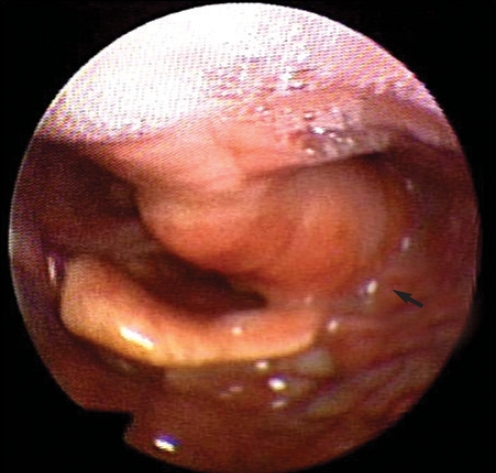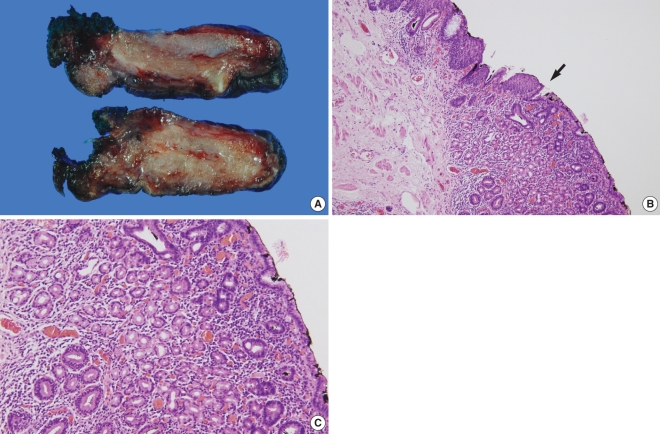Clin Exp Otorhinolaryngol.
2009 Jun;2(2):103-105. 10.3342/ceo.2009.2.2.103.
Gastric Choristoma of the Oropharynx
- Affiliations
-
- 1Department of Otorhinolaryngology, Seoul National University College of Medicine, Seoul, Korea. jhunhah@snu.ac.kr
- KMID: 2007194
- DOI: http://doi.org/10.3342/ceo.2009.2.2.103
Abstract
- Heterotopic gastric mucosa tissue is also called gastric choristoma, and this type of lesion can be found anywhere in the alimentary tract. However, gastric choristoma in the pharynx is very rare; only 10 cases of pharyngeal gastric choristoma have been reported in the English medical literature. A 32-yr-old woman was referred to our institution for the evaluation of a large mass that originated from the posterior wall of the oropharynx. The mass did not cause any symptoms except for the occasional sensation of a foreign body. Gadolinium-enhanced T1 weighted imaging showed a 5 cm-sized mass with central enhancement and hypointense portions, yet the radiological diagnosis was not clear. Transoral mass excision was performed with using electrocautery for making the diagnosis and for treating the mass. The microscopic analysis revealed gastric choristoma.
Keyword
MeSH Terms
Figure
Reference
-
1. Johnston C, Benjamin B, Harrison H, Kan A. Gastric heterotopia causing airway obstruction. Int J Pediatr Otorhinolaryngol. 1989; 9. 18(1):67–72. PMID: 2807756.
Article2. Borhan-Manesh F, Farnum JB. Incidence of heterotopic gastric mucosa in the upper oesophagus. Gut. 1991; 9. 32(9):968–972. PMID: 1916499.
Article3. Edwards J, Pearson S, Zalzal G. Foregut duplication cyst of the hypopharynx. Arch Otolaryngol Head Neck Surg. 2005; 12. 131(12):1112–1115. PMID: 16365227.
Article4. Fraser L, Howatson AG, MacGregor FB. Foregut duplication cyst of the pharynx. J Laryngol Otol. 2008; 7. 122(7):754–756. PMID: 18086334.
Article5. Hsu JM, Mortelliti AJ. Gastric choristoma of the hypopharynx presenting in an infant: a case report and review of the literature. Int J Pediatr Otorhinolaryngol. 2000; 11. 30. 56(1):53–58. PMID: 11074116.
Article6. Kim JK, Park KK. Foregut duplication cyst of the hypopharynx: a rare cause of upper airway obstruction. J Pediatr Surg. 2007; 6. 42(6):E5–E7. PMID: 17560193.
Article7. Azzie G, Beasley S. Diagnosis and treatment of foregut duplications. Semin Pediatr Surg. 2003; 2. 12(1):46–54. PMID: 12520472.
Article8. Wolff M, Rankow RM. Heterotopic gastric epithelium in the head and neck region. Ann Plast Surg. 1980; 1. 4(1):53–64. PMID: 7377677.
Article9. von Rahden BH, Stein HJ, Becker K, Siewert RJ. Esophageal adenocarcinomas in heterotopic gastric mucosa: review and report of a case with complete response to neoadjuvant radiochemotherapy. Dig Surg. 2005; 22(1-2):107–112. PMID: 15849472.
Article
- Full Text Links
- Actions
-
Cited
- CITED
-
- Close
- Share
- Similar articles
-
- Glial Choristoma Accompanied with Severe Bony Defect in Orbit in a Newborn
- A Case of Choristoma of Tongue Base
- A Case of Lingual Osseous Choristoma
- A Rare Adult Case of Choristoma in Nasopharynx Obstructing the Eustachian Tube: Case Report and Review of the Literature
- Bacterial Ball in Concha Bullosa: Report of a Case With Unusual Location




